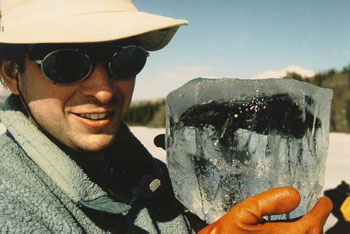Clues about origin of life found in meteorite
Clues about origin of life found in meteorite
mongabay.com
November 30, 2006
NASA scientists studying a rare type of meteorite have found organic materials that were formed in the early days of the solar system according to a paper published in the December 1 issue of the journal Science.
“Organic matter in meteorites is a subject of intense interest because this material formed at the dawn of the Solar System and may have seeded the early Earth with the building blocks of life,” explained a media release from the Johnson Space Center. “The Tagish Lake meteorite is especially valuable for this work because much of it was collected immediately after its fall over Canada in 2000 and has been maintained in a frozen state, minimizing terrestrial contamination. The collection and curation of the meteorite samples preserved its pristine state.”
“Similar objects have been reported from several meteorites since the 60’s. Some scientists believed these were space organisms, but others thought they were just terrestrial contamination,” said NASA space scientist Keiko Nakamura-Messenger, lead author of the paper.”But in the past, there was no way to determine for sure where these organic globules came from because they were simply too small. They are only 1/10,000 inch in size or less.”
Nakamura-Messenger says the organic globules in the Tagish Lake meteorites contained “very unusual hydrogen and nitrogen isotopic compositions” which indicated the materials were alien in nature.
 The 150-ton Tagish Lake meteorite crashed to Earth at 9:48 am on January 18, 2000. A scientific consortium of 4 universities and NASA has been studying the space rock since then. The above photo, taken in 2000, shows Michael Mazur of the University of Calgary holding fragments of the Tagish Lake Meteorite encased in ice. Photo by Dr. Alan Hildebrand of the University of Calgary. |
“The isotopic ratios in these globules show that they formed at temperatures of about -260° C, near absolute zero,” said Scott Messenger, NASA space scientist and co-author of the paper. “The organic globules most likely originated in the cold molecular cloud that gave birth to our Solar System, or at the outermost reaches of the early Solar System.”
The research may provide clues about the origin of life on Earth, say the scientists.
“If, as we suspect, this type of meteorite has been falling onto Earth throughout its entire history, then the Earth was seeded with these organic globules at the same time life was first forming here.” said Mike Zolensky, NASA cosmic mineralogist and a co-author of the paper.
According to the release, some biologists believe that forming a bubble-shape is the “first step on the path to biotic life.” As such, Nakamura-Messenger concludes, “We may be a step closer to knowing where our ancestors came from.”
This article is based on a news release from NASA’s Johnson Space Center. This article quotes extensively from that release.